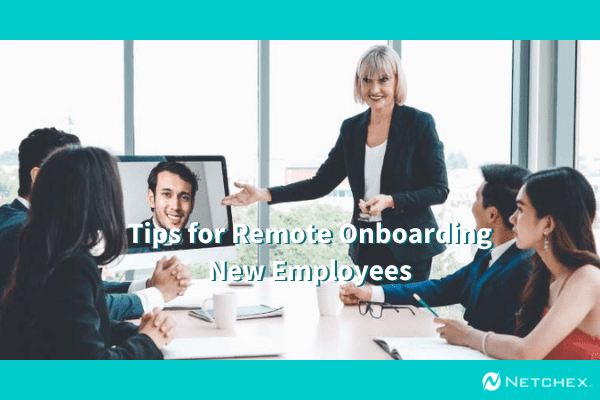Share
How are you welcoming new remote employees to the team? Do you have a personalized remote onboarding process, or do you just alter your in-person onboarding process? If your company is only do the latter, that might not be enough.
Onboarding time is especially important for remote workers who may never experience the office in-person. Take the time and make the extra effort. It will not only start remote employees off on the right foot, it will prove beneficial down line with retention, continuing education, and employee engagement.
Here are several tips on how to tailor your remote onboarding process for new hires joining your company virtually:
Start early (before the first day)
“Pre-boarding” is a useful term for getting started early. Have new employees complete their hiring paperwork before their first official day on the job. With online forms and onboarding software, new hires can sign key documents at their convenience. Don’t waste valuable time (and enthusiasm) on Day 1 with boring paperwork.
Be present and prepared
bBe sure to bring your A-game, especially when remote onboarding new employees. When meeting new hires in person, you can respond to body language and other social cues that won’t be as obvious with remote employees. It can take extra effort and organization to avoid video meeting fatigue and keep everyone motivated.
Develop clear plans for the first day, first week, and first month. Give your new employees a roadmap for what to expect during and after the training process. Work together to create an achievable development plan.
Send an enthusiastic welcome
Everybody appreciates a personal note. Your initial job offers might include words like “congratulations” but it can help to send a less formal welcome as well. Get personalized notes from managers, future colleagues, or executives at your company.
When remote onboarding, send a welcome package. Throw in some company swag: T-shirts, koozies, and coffee mugs are popular. Something as simple as a T-shirt can make virtual employees feel more connected to their new company.
Make sure workers are fully equipped at home
Some of your job applicants may have fully equipped home offices. Others will be struggling along with older laptops and outdated software. Your budget will be a factor, but equipment can be a good investment with a remote workforce.
Upgraded monitors and peripheral hardware may improve productivity. If you provide laptops for remote workers, then you can better protect the security of your own software and client information.
Create a memorable first day
How would you normally welcome your in-person staff? Try to adapt and recreate that experience for remote employees. Give a tour of the office and introduce key colleagues, including the people they’ll be emailing in the future.
Include a virtual lunch session for more casual networking. If you send remote workers a $20 Grubhub gift card, they’ll be able to remotely participate in a free lunch. Provide icebreaker conversation prompts so that members of the team can discuss their personal interests.
Share appropriate documentation
Just like with in-person staff, you’ll want to provide the employee manual and other important documents to remote workers. Paper booklets can be included with the welcome packets, but most employees will be just as happy with PDF’s.
When you developed your long term remote work policy, you may have created a separate document for remote onboarding, or they may have their own section in the employee manual. Make sure remote workers understand your security protocols and how to access employee benefits.
Talk about culture
The workplace culture might speak for itself with in-person employees. For remote workers, you’ll need to make a point of discussing and demonstrating culture. Ultimately, your goal will be to create a sense of belonging. It’s extra important for remote workers to feel welcome and appreciated by their colleagues.
Assign a mentor
You can’t explain everything in formal training sessions. When little problems arise in the weeks ahead, new employees may not know who to contact. Some workers will be reluctant to ask their supervisors for help.
Consider pairing each new hire with a peer mentor. Another remote worker can answer questions about VPNs and troubleshooting problems after normal business hours. The mentor will be a more experienced worker in a similar role, a more casual point of contact for getting help.
Make training an ongoing process
Most workers want to continue adding skills and getting better at their jobs. Remote onboarding should only be the first step in long term training opportunities. Use your Learning Management System to promote continuous learning for the whole company.
After new employees understand their job and relevant tasks, have their manager put together a personal development and growth plan. From month to month and year to year, remote employees will be happier with your company if they see themselves growing professionally over time.
Check in often
It’s better to communicate too much, rather than too little with new hires. Have their direct manager or supervisor check in repeatedly, scheduling one-on-one meetings during the first couple of days.
During the initial onboarding and training, those check-ins should happen multiple times a week. As they get the hang of the job, you can dial back the frequency of the meetings. Remote work can lead to feelings of loneliness and isolation, so be sure to stay connected to these workers, whether that’s through mentors or social events.
Remote workers bring a unique set of challenges and opportunities to every business. Get started on the right track with a robust remote onboarding program.
Discover how remote onboarding with Netchex software can help you improve your overall onboarding experience:
Industry news & tips sent straight to your inbox!
Enter your email below to subscribe to industry news, product updates, and tips.
